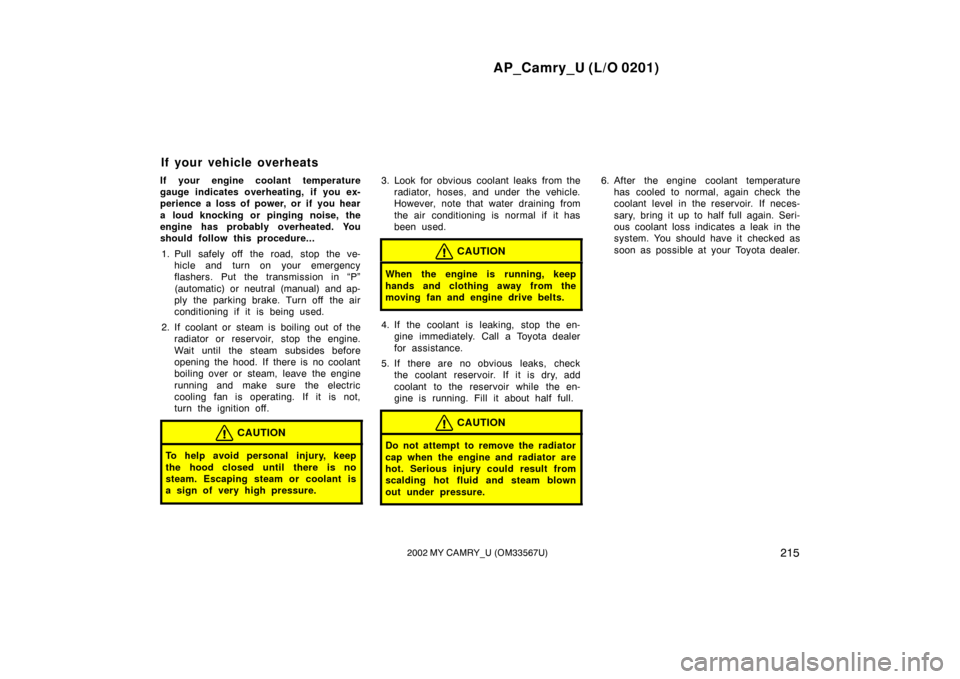Page 214 of 293
AP_Camry_U (L/O 0201)
2102002 MY CAMRY_U (OM33567U)
IN CASE OF AN EMERGENCY
If your vehicle will not start211
. . . . . . . . . . . . . . . . . . . . . . . . . . . . . . . . . . .
If your engine stalls while driving 214
. . . . . . . . . . . . . . . . . . . . . . . . . . . . .
If you cannot increase the engine speed 214
. . . . . . . . . . . . . . . . . . . . . .
If your vehicle overheats 215
. . . . . . . . . . . . . . . . . . . . . . . . . . . . . . . . . . . . \
If you have a flat tire 216
. . . . . . . . . . . . . . . . . . . . . . . . . . . . . . . . . . . . \
. . . . .
If your vehicle needs to be towed 224
. . . . . . . . . . . . . . . . . . . . . . . . . . . . .
If you cannot shift automatic transmission selector lever 228
. . . . . . . .
If you lose your keys 229
. . . . . . . . . . . . . . . . . . . . . . . . . . . . . . . . . . . . \
. . . .
If you lose your wireless remote control transmitter 229
. . . . . . . . . . . . .
SECTION 4
Page 215 of 293

AP_Camry_U (L/O 0201)
2112002 MY CAMRY_U (OM33567U)
Before making these checks, make sure
you have followed the correct starting
procedure given in “How to start the
engine” on page 197 in Section 3 and that
you have sufficient fuel. If your vehicle is
equipped with the engine immobiliser
system, also check whether the other
keys will start the engine. If they work,
your key may be broken. Have the key
checked at your Toyota dealer. If none of
your keys work, the system is possibly
broken. Call your Toyota dealer. (See
“Keys (with engine immobiliser system)”
on page 10 in Section 1−2.)
If the engine is not turning over or is
turning over too slowly— 1. Check that the battery terminals are tight and clean.
2. If the battery terminals are O.K., switch on the interior light.
3. If the light is out, dim or goes out when the starter is cranked, the battery
is discharged. You may try jump start-
ing. See “(c) Jump starting” on page
212 for further instructions.
If the light is O.K., but the engine still will
not start, it needs adjustment or repair.
Call a Toyota dealer or qualified repair
shop.NOTICE
Do not pull� or push�start the ve-
hicle. It may damage the vehicle or
cause a collision when the engine
starts. Also the three�way catalytic
converter may overheat and become a
fire hazard.
If the engine turns over at its normal
speed but will not start— 1. The engine may be flooded because of repeated cranking. See “(b) Starting a
flooded engine” on page 211 for further
instructions.
2. If the engine still will not start, it needs adjustment or repair. Call a Toyota
dealer or qualified repair shop. If the engine will not start, your engine
may be flooded because of repeated
cranking.
If this happens, turn the key to “START”
with the accelerator pedal held down.
Keep the key and accelerator pedal in
these positions for 15 seconds and re-
lease them. Then try starting the engine
with your foot off the accelerator pedal.
If the engine does not start after 15 se-
conds of cranking, release the key, wait
a few minutes and try again.
If the engine still will not start, it needs
adjustment or repair. Call a Toyota dealer
or qualified repair shop for assistance.
NOTICE
Do not crank for more than 30 se-
conds at a time. This may overheat
the starter and wiring systems.
If your vehicle will not start—
(a) Simple checks
(b) Starting a flooded engine
Page 219 of 293

AP_Camry_U (L/O 0201)
2152002 MY CAMRY_U (OM33567U)
If your engine coolant temperature
gauge indicates overheating, if you ex-
perience a loss of power, or if you hear
a loud knocking or pinging noise, the
engine has probably overheated. You
should follow this procedure...1. Pull safely off the road, stop the ve- hicle and turn on your emergency
flashers. Put the transmission in “P”
(automatic) or neutral (manual) and ap-
ply the parking brake. Turn off the air
conditioning if it is being used.
2. If coolant or steam is boiling out of the radiator or reservoir, stop the engine.
Wait until the steam subsides before
opening the hood. If there is no coolant
boiling over or steam, leave the engine
running and make sure the electric
cooling fan is operating. If it is not,
turn the ignition off.
CAUTION
To help avoid personal injury, keep
the hood closed until there is no
steam. Escaping steam or coolant is
a sign of very high pressure.
3. Look for obvious coolant leaks from theradiator, hoses, and under the vehicle.
However, note that water draining from
the air conditioning is normal if it has
been used.
CAUTION
When the engine is running, keep
hands and clothing away from the
moving fan and engine drive belts.
4. If the coolant is leaking, stop the en-gine immediately. Call a Toyota dealer
for assistance.
5. If there are no obvious leaks, check the coolant reservoir. If it is dry, add
coolant to the reservoir while the en-
gine is running. Fill it about half full.
CAUTION
Do not attempt to remove the radiator
cap when the engine and radiator are
hot. Serious injury could result from
scalding hot fluid and steam blown
out under pressure.
6. After the engine coolant temperaturehas cooled to normal, again check the
coolant level in the reservoir. If neces-
sary, bring it up to half full again. Seri-
ous coolant loss indicates a leak in the
system. You s hould have it checked as
soon as possible at your Toyota dealer.
If your vehicle overheats
Page 290 of 293

AP_Camry_U (L/O 0201)
2002 MY CAMRY_U (OM33567U)
Publication No. OM33567U
Part No. 01999-33567
Printed in Japan 01−0112 −00
Quick index
� If a service reminder indicator or warning buzzer comes on 99 . . . . . . . . .
� If your vehicle will not start 211 . . . . . . . . . . . . . . . . . . . . . . . . . . . . . . . . . . . . .\
. .
� If your engine stalls while driving 214 . . . . . . . . . . . . . . . . . . . . . . . . . . . . . . . . . .
� If your vehicle overheats 215 . . . . . . . . . . . . . . . . . . . . . . . . . . . . . . . . . . . . .\
. . . . .
� If you have a flat tire 216 . . . . . . . . . . . . . . . . . . . . . . . . . . . . . . . . . . . . .\
. . . . . . . .
� If your vehicle needs to be towed 224 . . . . . . . . . . . . . . . . . . . . . . . . . . . . . . . . .
� Tips for driving during break −in period 181 . . . . . . . . . . . . . . . . . . . . . . . . . . . . .
� How to start the engine 197 . . . . . . . . . . . . . . . . . . . . . . . . . . . . . . . . . . . . .\
. . . . . .
� General maintenance 238 . . . . . . . . . . . . . . . . . . . . . . . . . . . . . . . . . . . . .\
. . . . . . . . .
� Complete index NO TAG . . . . . . . . . . . . . . . . . . . . . . . . . . . . . . . . . . . . .\
. . . . . . . . . .
Gas station information
Fuel type:
2AZ −FE engine: UNLEADED gasoline, Octane Rating 87
(Research Octane Number 91) or higher
1MZ −FE engine: UNLEADED gasoline, Octane Rating 87
(Research Octane Number 91) or higher.
For improved vehicle performance, the use of premium unleaded
gasoline with an Octane Rating of 91 (Research Octane Number 96)
or higher is recommended.
See page 181 for detailed information.
Fuel tank capacity:
70 L (18.5 gal., 15.4 lmp. gal.)
Engine oil:
API grade SJ “Energy −Conserving”, SL “Energy −Conserving” or ILSAC
multigrade engine oil is recommended.
See page 251 for detailed information.
Automatic transmission fluid: Automatic transmission fluid Type T −IV
Tire information: See pages 255 through 260.
Tire pressure: See page 278.
bU8
I